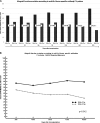Anti-HLA Donor-Specific IgG Subclasses and C1q-binding Evolution in Posttransplant Monitoring
- PMID: 30234154
- PMCID: PMC6133409
- DOI: 10.1097/TXD.0000000000000823
Anti-HLA Donor-Specific IgG Subclasses and C1q-binding Evolution in Posttransplant Monitoring
Abstract
Background: The identification of low-level antibodies by single-antigen bead methodology has brought advancements to risk evaluation of kidney transplant recipients. However, the use of mean fluorescence intensity (MFI) to quantify antibodies and to guide therapy is not enough. Notably, immunoglobulin G (IgG) subclass switching is hypothesized to follow a programmed sequence after an emergency signal from the germinal center. In transplantation this process is not clear yet. In the present study, we sequentially evaluate anti-HLA donor specific antibody (DSA) subclasses, their profile changes, and C1q-binding ability and the influence of those characteristics on antibody mediated rejection (AMR) occurrence and allograft function.
Methods: A total of 30 DSA-positive patients were tested for IgG subclass content and C1q-binding in sequential serum samples.
Results: Twenty-one patients were DSA-positive before transplant; patients sensitized only by transfusion or pregnancies had IgG1 and/or IgG3, and patients sensitized by both transfusion and pregnancies or previous transplant showed a broader range of IgG subclasses. C1q binding was detected in high MFI made up of IgG1 or multiple IgG subclasses. Only 4 patients were positive for C1q posttransplantation and 3 of these showed an increase in MFI, changes in subclasses patterns, AMR, and allograft dysfunction.
Conclusions: Posttransplant evaluation of DSA subclasses and the ability to bind C1q may be informative for both AMR occurrence and allograft dysfunction. Monitoring these events may help to better define risk and interventional time points.
Conflict of interest statement
R.G.-P. provides consultation for HLA scientific data for One Lambda, Inc. The other authors declare no conflicts of interest.
Figures



References
-
- Tait BD, Hudson F, Cantwell L, et al. Review article: Luminex technology for HLA antibody detection in organ transplantation. Nephrology (Carlton). 2009;14:247–254. - PubMed
-
- Gibney EM, Cagle LR, Freed B, et al. Detection of donor-specific antibodies using HLA-coated microspheres: another tool for kidney transplant risk stratification. Nephrol Dial Transplant. 2006;21:2625–2629. - PubMed
-
- Becker LE, Süsal C, Morath C. Kidney transplantation across HLA and ABO antibody barriers. Curr Opin Organ Transplant. 2013;18:445–454. - PubMed
LinkOut - more resources
Full Text Sources
Other Literature Sources
Research Materials

